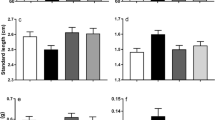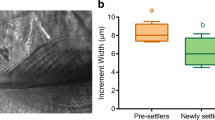Abstract
The potential for environmental and physiological modification of elemental incorporation in otoliths is significant and must be validated before otoliths can be used reliably to estimate water parameters over the life history of a fish. We experimentally manipulated temperature and diet quantity for juvenile, sub-adult, and adult Acanthochromis polyacanthus, a tropical damselfish of the SW Pacific. Significant interactive effects between life history stage, temperature and food quantity were observed for otolith Ba/Ca, while significant interactions between stage and food were observed for Sr/Ca. Specific growth rates were negatively correlated with DBa and DSr for juveniles and sub-adults. These interactions indicated elemental incorporation dynamics varied depending on the life history stage, suggesting variation in effects of stage-specific metabolism or reproductive status. Our results highlight complex responses of elemental incorporation to both endogenous and exogenous factors. Interpretations of life history transects across otoliths must account for these effects to avoid confounding environmental variability with ontogenetic changes in physiology.



Similar content being viewed by others
References
Andrews JC, Gentien P (1982) Upwelling as a source of nutrients for the Great Barrier Reef ecosystems: a solution to Darwin’s question? Mar Ecol Prog Ser 8:257–269
Bath GE, Thorrold SR, Jones CM, Campana SE, McLaren JW, Lam JWH (2000) Strontium and barium uptake in aragonitic otoliths of marine fish. Geochim Cosmochim Acta 64:1705–1714
Baumann H, Peck MA, Herrmann JP (2005) Short-term decoupling of otolith and somatic growth induced by food level changes in postlarval Baltic sprat, Sprattus sprattus. Mar Freshw Res 56:539–547
Berkelmans R, De’ath G, Kininmonth S, Skirving WJ (2004) A comparison of the 1998 and 2002 coral bleaching events on the Great Barrier Reef: spatial correlation, patterns, and predictions. Coral Reefs 23:74–83
Brodie J, De’ath G, Devlin M, Furnas M, Wright M (2007) Spatial and temporal patterns of near-surface chlorophyll a in the Great Barrier Reef lagoon. Mar Freshw Res 58:342–353
Campana SE (1999) Chemistry and composition of fish otoliths: pathways, mechanisms and applications. Mar Ecol Prog Ser 188:263–297
Campana SE, Nielson JD (1985) Microstructure of fish otoliths. Can J Fish Aquat Sci 42:1014–1032
Chen HL, Shen KN, Chang CW, Iizuka Y, Tzeng WN (2008) Effects of water temperature, salinity and feeding regimes on metamorphosis, growth and otolith Sr:Ca ratios of Megalops cyprinoides leptocephali. Aquat Biol 3:41–50
Chesney EJ, McKee BM, Blanchard T, Chan LH (1998) Chemistry of otoliths from juvenile menhaden Brevoortia patronus: evaluating strontium, strontium:calcium and strontium isotope ratios as environmental indicators. Mar Ecol Prog Ser 171:261–273
Cusack M, Freer A (2008) Biomineralization: elemental and organic influence in carbonate systems. Chem Rev 108:4433–4454
de Pontual H, Lagardere F, Amara R, Bohn M, Ogor A (2003) Influence of ontogenetic and environmental changes in the otolith microchemistry of juvenile sole (Solea solea). J Sea Res 50:199–210
de Villiers S (1999) Seawater strontium and Sr/Ca variability in the Atlantic and Pacific oceans. Earth Planet Sci Lett 171:623–634
Elsdon TS, Gillanders BM (2003a) Relationship between water and otolith elemental concentrations in juvenile black bream Acanthopagrus butcheri. Mar Ecol Prog Ser 260:263–272
Elsdon TS, Gillanders BM (2003b) Reconstructing migratory patterns of fish based on environmental influences on otolith chemistry. Rev Fish Biol Fish 13:219–235
Elsdon TS, Wells BK, Campana SE, Gillanders BM, Jones CM, Limburg KE, Secor DH, Thorrold SR, Walther BD (2008) Otolith chemistry to describe movements and life-history parameters of fishes: hypotheses, assumptions, limitations and inferences. Oceanogr Mar Biol Ann Rev 46:297–330
Fowler AJ, Campana SE, Jones CM, Thorrold SR (1995) Experimental assessment of the effect of temperature and salinity on elemental composition of otoliths using laser ablation ICPMS. Can J Fish Aquat Sci 52:1431–1441
Fuiman LA, Hoff GR (1995) Natural variation in elemental composition of sagittae from red drum. J Fish Biol 47:940–955
Gabitov RI, Cohen AL, Gaetani GA, Holcomb M, Watson EB (2006) The impact of crystal growth rate on element ratios in aragonite: an experimental approach to understanding vital effects. Geochim Cosmochim Acta 70:A187
Gaetani GA, Cohen AL (2006) Element partitioning during precipitation of aragonite from seawater: a framework for understanding paleoproxies. Geochim Cosmochim Acta 70:4617–4634
Gauldie RW, Fournier DA, Dunlop DE, Coote G (1986) Atomic emission and proton microprobe studies of the ion content of otoliths of chinook salmon aimed at recovering the temperature life history of individuals. Comp Biochem Phys A 84:607–615
Hamer PA, Jenkins GP (2007) Comparison of spatial variation in otolith chemistry of two fish species and relationships with water chemistry and otolith growth. J Fish Biol 71:1035–1055
Hoff GR, Fuiman LA (1993) Morphometry and composition of red drum otoliths: changes associated with temperature, somatic growth rate, and age. Comp Biochem Phys A 106:209–219
Holcomb M, Cohen AL, Gabitov RI, Hutter JL (2009) Compositional and morphological features of aragonite precipitated experimentally from seawater and biogenically by corals. Geochim Cosmochim Acta 73:4166–4179
Kalish JM (1989) Otolith microchemistry: validation of the effects of physiology, age and environment on otolith composition. J Exp Mar Biol Ecol 132:151–178
Kalish JM (1991) Determinants of otolith chemistry: seasonal variation in the composition of blood plasma, endolymph and otoliths of bearded rock cod Pseudophycis barbatus. Mar Ecol Prog Ser 74:137–159
Kalish JM (1992) Formation of a stress-induced chemical check in fish otoliths. J Exp Mar Biol Ecol 162:265–277
Kavanagh KD (2000) Larval brooding in the marine damselfish Acanthochromis polyacanthus (Pomacentridae) is correlated with highly divergent morphology, ontogeny and life-history traits. Bull Mar Sci 66:321–337
Kingsford MJ, Hughes JM (2005) Patterns of growth, mortality, and size of the tropical damselfish Acanthochromis polyacanthus across the continental shelf of the Great Barrier Reef. Fish Bull 103:561–573
Kingsford MJ, Hughes JM, Patterson HM (2009) Otolith chemistry of the non-dispersing reef fish Acanthochromis polyacanthus: cross-shelf patterns from the central Great Barrier Reef. Mar Ecol Prog Ser 377:279–288
Lin SH, Chang CW, Iizuka Y, Tzeng WN (2007) Salinities, not diets, affect strontium/calcium ratios in otoliths of Anguilla japonica. J Exp Mar Biol Ecol 341:254–263
Marshall JF, McCulloch MT (2002) An assessment of the Sr/Ca ratio in shallow water hermatypic corals as a proxy for sea surface temperature. Geochim Cosmochim Acta 66:3263–3280
Martin GB, Thorrold SR (2005) Temperature and salinity effects on magnesium, manganese, and barium incorporation in otoliths of larval and early juvenile spot Leiostomus xanthurus. Mar Ecol Prog Ser 293:223–232
Martin GB, Thorrold SR, Jones CM (2004) Temperature and salinity effects on strontium incorporation in otoliths of larval spot (Leiostomus xanthurus). Can J Fish Aquat Sci 61:34–42
McCulloch M, Fallon S, Wyndham T, Hendy E, Lough J, Barnes D (2003) Coral record of increased sediment flux to the inner Great Barrier Reef since European settlement. Nature 421:727–730
Meibom A, Mostefaoui S, Cuif JP, Dauphin Y, Houlbreque F, Dunbar R, Constantz B (2007) Biological forcing controls the chemistry of reef-building coral skeleton. Geophys Res Lett. doi:10.1029/2006GL028657
Miller JA (2009) The effects of temperature and water concentration on the otolith incorporation of barium and manganese in black rockfish Sebastes melanops. J Fish Biol 75:39–60
Mommsen TP, Vijayan MM, Moon TW (1999) Cortisol in teleosts: dynamics, mechanisms of action, and metabolic regulation. Rev Fish Biol Fish 9:211–268
Morales-Nin B, Swan SC, Gordon JDM, Palmer M, Geffen AJ, Shimmield T, Sawyer T (2005) Age-related trends in otolith chemistry of Merluccius merluccius from the north-eastern Atlantic Ocean and the western Mediterranean Sea. Mar Freshw Res 56:599–607
Morse JW, Bender ML (1990) Partition coefficients in calcite—examination of factors influencing the validity of experimental results and their application to natural systems. Chem Geol 82:265–277
Munday PL, Kingsford MJ, O’Callaghan M, Donelson JM (2008) Elevated temperature restricts growth potential of the coral reef fish Acanthochromis polyacanthus. Coral Reefs 27:927–931
Otake T, Ishii T, Ishii T, Nakahara M, Nakamura R (1997) Changes in otolith strontium:calcium ratios in metamorphosing Conger myriaster leptocephali. Mar Biol 128:565–572
Papadopoulou C, Kanias GD, Moraitopoulou-Kassimati E (1980) Trace element content in fish otoliths in relation to age and size. Mar Pollut Bull 11:68–72
Payan P, De Pontual H, Boeuf G, Mayer-Gostan N (2004) Endolymph chemistry and otolith growth in fish. Cr Palevol 3:535–547
Radtke RL (1989) Strontium-calcium concentration ratios in fish otoliths as environmental indicators. Comp Biochem Physiol A 92:189–193
Sadovy Y, Severin KP (1992) Trace elements in biogenic aragonite: correlation of body growth rate and strontium levels in the otoliths of the white grunt, Haemulon plumieri (Pisces: Haemulidae). Bull Mar Sci 50:237–257
Sadovy Y, Severin KP (1994) Elemental patterns in red hind (Epinephelus guttatus) otoliths from Bermuda and Puerto Rico reflect growth rate, not temperature. Can J Fish Aquat Sci 51:133–141
Sandin SA, Regetz J, Hamilton SL (2005) Testing larval fish dispersal hypotheses using maximum likelihood analysis of otolith chemistry data. Mar Freshw Res 56:725–734
Schone BR (2008) The curse of physiology—challenges and opportunities in the interpretation of geochemical data from mollusk shells. Geo-Marine Letters 28:269–285
Sinclair DJ (2005) Correlated trace element “vital effects” in tropical corals: a new geochemical tool for probing biomineralization. Geochim Cosmochim Acta 69:3265–3284
Sinclair DJ, McCulloch MT (2004) Corals record low mobile barium concentrations in the Burdekin River during the 1974 flood: evidence for limited Ba supply to rivers? Palaeogeogr Palaeoclimatol Palaeoecol 214:155–174
Sinclair DJ, Risk MJ (2006) A numerical model of trace-element coprecipitation in a physicochemical calcification system: application to coral biomineralization and trace-element ‘vital effects’. Geochim Cosmochim Acta 70:3855–3868
Sinclair DJ, Kinsley LPJ, McCulloch MT (1998) High resolution analysis of trace elements in corals by laser ablation ICP-MS. Geochim Cosmochim Acta 62:1889–1901
Townsend DW, Radtke RL, Morrison MA, Folsom SD (1989) Recruitment implications of larval herring overwintering distributions in the Gulf of Maine, inferred using a new otolith technique. Mar Ecol Prog Ser 55:1–13
Underwood AJ (1997) Experiments in ecology: their logical design and interpretation using analysis of variance. Cambridge University Press, Cambridge
Walther BD, Thorrold SR (2006) Water, not food, contributes the majority of strontium and barium deposited in the otoliths of a marine fish. Mar Ecol Prog Ser 311:125–130
Wells BK, Rieman BE, Clayton JL, Horan DL, Jones CM (2003) Relationships between water, otolith, and scale chemistries of westslope cutthroat trout from the Coeur d’Alene River, Idaho: the potential application of hard-part chemistry to describe movements in freshwater. Trans Am Fish Soc 132:409–424
Wolanski E, Jones M (1981) Physical properties of Great Barrier Reef lagoon waters near Townsville. I Effects of Burdekin River floods. Aust J Mar Freshw Res 32:305–319
Acknowledgements
BDW was supported by the ARC Centre of Excellence for Coral Reef Studies and Australian Research Council funds awarded to MJK and MTM, respectively. We thank Reef HQ for supplying fish and MARFU staff for assistance with the experiments.
Author information
Authors and Affiliations
Corresponding author
Rights and permissions
About this article
Cite this article
Walther, B.D., Kingsford, M.J., O’Callaghan, M.D. et al. Interactive effects of ontogeny, food ration and temperature on elemental incorporation in otoliths of a coral reef fish. Environ Biol Fish 89, 441–451 (2010). https://doi.org/10.1007/s10641-010-9661-6
Received:
Accepted:
Published:
Issue Date:
DOI: https://doi.org/10.1007/s10641-010-9661-6




